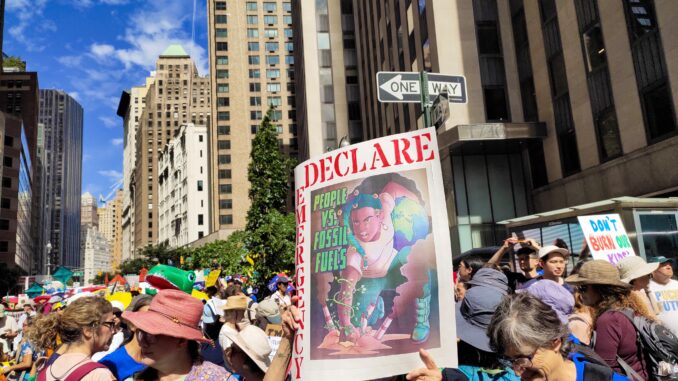
BY JOSH NARISMA
Thousands of people surged into the streets of midtown Manhattan on September 17 to protest the use of fossil fuels. The protest drew climate activists of all backgrounds, including indigenous advocates, eco-socialists, anti-militarists, and radical vegans.
The March to End Fossil Fuels started on Broadway between 55th and 56th street and ended along 1st Avenue, near the United Nations: the march coincided with the opening of the UN General Assembly, which brings scores of world leaders to New York.
According to Oil Change International, among the main countries currently funding fossil fuel projects, “the U.S. has approved the most fossil fuel finance in 2023 so far, providing a total of $1.5 billion for four projects.” This is despite a 2021 Executive Order that placed the climate crisis at the center of the United States foreign policy, and despite the United States administration’s support for the Glasgow Statement, which launched at the 2021 United Nations Climate Change Conference (COP26).
According to Oil Change International, the Glasgow Statement was signed by “34 countries and five public finance institutions […] to end new direct international public finance for fossil fuels by the end of 2022 and instead prioritize public finance for clean energy.” It is the first such international commitment.
Much of the rally directed criticism at President Biden, with marchers raising banners such as “BIDEN END FOSSIL FUELS” and “Biden: Climate Emergency NOW!”
The U.S. National Aeronautics and Space Agency confirmed earlier this month that rising greenhouse emissions have caused “the summer of 2023 [to be] Earth’s hottest since global records began in 1880,” resulting in devastating heat waves, wildfires, and extreme flooding. The public’s fear of these ecological crises was reflected in posters declaring “Don’t Burn Our Kids,” “Fossil Fuels Kill,” and, perhaps most haunting, “This Summer Is The Coolest of the Rest of Our Lives.”
Among the rally’s attendants was Katie Mason, a graduate student pursuing social psychology at New York University. “I’m concerned for our future,” she said. “I hope this rally can convince people in power to make better decisions.” Mason was accompanied by fellow NYU students conducting surveys at the march to uncover why people join political rallies. “I want to know why people care about this,” she explained.
Climate change is an all-encompassing term that describes the consequences of the earth’s warming: rising sea levels, melting glaciers, accelerating ice melt in the Arctic, and shifts in growth patterns for plant life. This is caused by the burning of fossil fuels including coal, oil, and natural gas. This releases greenhouse gasses such as carbon dioxide, methane, and nitrous oxide, which trap heat in earth’s atmosphere.
Global efforts to mitigate climate change have been inconsistent. The most prominent example of recent times is the Paris Accords, which was ratified at COP21 and currently contains 194 parties. Although the agreement was internationally lauded, the Brookings Institution stated it is hard to measure the treaty’s success, and it has been criticized for being insufficiently binding.
According to the Washington Post, President Biden recently banned oil drilling across 10.6 million acres of the National Petroleum Reserve in Alaska; however, he has not reversed the controversial ConocoPhillips’ Willow Project. The Associated Press detailed Biden’s approval of that project earlier this year, which is expected to produce up to 180,000 barrels of oil a day.
The last major climate march in New York City was in September 2019, when Swedish environmental activist Greta Thunberg demanded global leaders take action against global warming. While such public protests were derailed by the COVID-19 pandemic, the movement is surging again and members are calling upon Biden to end fossil fuel usage by stopping oil and gas projects, phasing down drilling, and declaring a climate emergency. According to the organization’s website, over 75,000 people joined the march, making it the largest climate demonstration since Biden took office.
“I’m here for so many reasons,” said Sally Jones, Chair of Peace Action Fund of New York State. “I’m here because everybody should be here, number one. We’re at a critical point where, you know, if people can pressure enough through every type of action they do, maybe we can turn things in the other direction.”
Jones said she recently took a trip across the northern U.S., where the presence of the fossil fuel industry is painfully felt. “They’re fracking, they’re drilling, people are getting jobs… Whatever we do has to make sure that the people that rely on fossil fuels are accounted for.” Jones attended the march as part of the anti-militarism contingent.
The ‘Anti-Militarism Hub’ comprised groups such as the Women’s International League for Peace and Freedom (WILPF) and CODEPINK, a feminist grassroots organization. According to CODEPINK, the Anti-Militarism Hub supports goals such as cutting the annual Pentagon budget, reallocating savings to Green New Deal initiatives, and achieving 50% reduction in U.S. military emissions by 2030.
The march culminated in a rousing speech by Congresswoman Alexandria Ocasio-Cortez, where she announced that the fossil fuel industry is “starting to buckle and crack.” She thanked the crowd for attending and declared, “We will not give up!” Three days later, the Climate Ambition Summit was held at the UN Headquarters. President Biden was notably absent, much to the outrage of various environmental groups.
